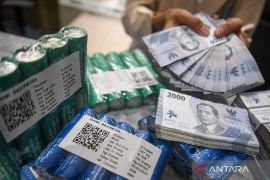"Point to point the Indonesian currency depreciated 0.97 percent to close at the level of 11,675 per dollar," Tirta Segara, the Executive Director of the Communications Department of the central bank, said here on Thursday.
Tita said the pressure on exchange rate is brought about by corporate demand which tends to increase to follow the seasonal repayment of foreign debts and repatriation of dividend or coupon.
In addition, the trend of exchange rate is also determined by the behavior of investors who are awaiting the result of the presidential elections in July.
"However, further pressure on rupiah would be offset by continuing inflows of foreign capital into rupiah assets," Tirta said.
He said the country suffered a trade deficit, which he described as seasonal while improvement is recorded in its financial account.
In April 2014, the country suffered a trade deficit of US$1.96 billion on seasonal factor with the Islamic fasting month and Idul Fitri, he said.
Imports of commodities other than oil and gas rose driven by a rise in the import of capital goods like machines and mechanical equipment and electrical equipment.
Meanwhile, exports of natural resource commodities other than oil and gas such as coal and palm oil declined with weak demand from mainly from China and India.
The two Asian giants have been among the main importer of the countrys major export earners, however, exports of manufactured goods showed a significant growth .
The central bank predicted the countrys trade balance would improve in the coming months with growing exports of manufactured commodities to follow the improved trend of the global economy and import control as well as moderation in domestic demand.
Meanwhile, the countrys financial account would continue to improve with inflows of foreign capital attracted by encouraging domestic economic prospects.
Until May 2014, inflows of foreign portfolio into the domestic financial market already reached US$11.04 billion.
With the trend, by the end of May 2014, the countrys foreign exchange reserves rose US$2 billion to US$107 billion enough to cover imports and service the governments foreign debts for 6.2 months.
It is well above the international adequacy standard of around three months, Tirta said.(*)
Editor: Heru Purwanto
Copyright © ANTARA 2014











